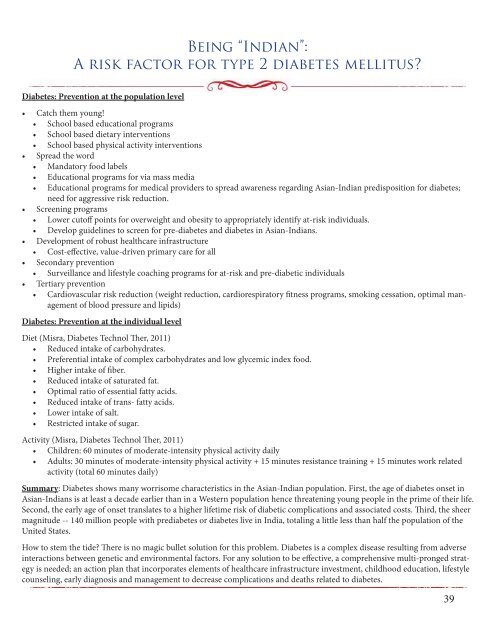gautam samadder, md - American Association of Physicians of ...
gautam samadder, md - American Association of Physicians of ...
gautam samadder, md - American Association of Physicians of ...
Create successful ePaper yourself
Turn your PDF publications into a flip-book with our unique Google optimized e-Paper software.
Being “Indian”:<br />
A risk factor for type 2 diabetes mellitus?<br />
Diabetes: Prevention at the population level<br />
<br />
<br />
<br />
<br />
<br />
<br />
Catch them young!<br />
School based educational programs<br />
School based dietary interventions<br />
School based physical activity interventions<br />
Spread the word<br />
Mandatory food labels<br />
Educational programs for via mass media<br />
Educational programs for medical providers to spread awareness regarding Asian-Indian predisposition for diabetes;<br />
need for aggressive risk reduction.<br />
Screening programs<br />
Lower cut<strong>of</strong>f points for overweight and obesity to appropriately identify at-risk individuals.<br />
Develop guidelines to screen for pre-diabetes and diabetes in Asian-Indians.<br />
Development <strong>of</strong> robust healthcare infrastructure<br />
Cost-effective, value-driven primary care for all<br />
Secondary prevention<br />
Surveillance and lifestyle coaching programs for at-risk and pre-diabetic individuals<br />
Tertiary prevention<br />
Cardiovascular risk reduction (weight reduction, cardiorespiratory fitness programs, smoking cessation, optimal management<br />
<strong>of</strong> blood pressure and lipids)<br />
Diabetes: Prevention at the individual level<br />
Diet (Misra, Diabetes Technol Ther, 2011)<br />
Reduced intake <strong>of</strong> carbohydrates.<br />
Preferential intake <strong>of</strong> complex carbohydrates and low glycemic index food.<br />
Higher intake <strong>of</strong> fiber.<br />
Reduced intake <strong>of</strong> saturated fat.<br />
Optimal ratio <strong>of</strong> essential fatty acids.<br />
Reduced intake <strong>of</strong> trans- fatty acids.<br />
Lower intake <strong>of</strong> salt.<br />
Restricted intake <strong>of</strong> sugar.<br />
Activity (Misra, Diabetes Technol Ther, 2011)<br />
Children: 60 minutes <strong>of</strong> moderate-intensity physical activity daily<br />
Adults: 30 minutes <strong>of</strong> moderate-intensity physical activity + 15 minutes resistance training + 15 minutes work related<br />
activity (total 60 minutes daily)<br />
Summary: Diabetes shows many worrisome characteristics in the Asian-Indian population. First, the age <strong>of</strong> diabetes onset in<br />
Asian-Indians is at least a decade earlier than in a Western population hence threatening young people in the prime <strong>of</strong> their life.<br />
Second, the early age <strong>of</strong> onset translates to a higher lifetime risk <strong>of</strong> diabetic complications and associated costs. Third, the sheer<br />
magnitude -- 140 million people with prediabetes or diabetes live in India, totaling a little less than half the population <strong>of</strong> the<br />
United States.<br />
How to stem the tide? There is no magic bullet solution for this problem. Diabetes is a complex disease resulting from adverse<br />
interactions between genetic and environmental factors. For any solution to be effective, a comprehensive multi-pronged strategy<br />
is needed; an action plan that incorporates elements <strong>of</strong> healthcare infrastructure investment, childhood education, lifestyle<br />
counseling, early diagnosis and management to decrease complications and deaths related to diabetes.<br />
39
















